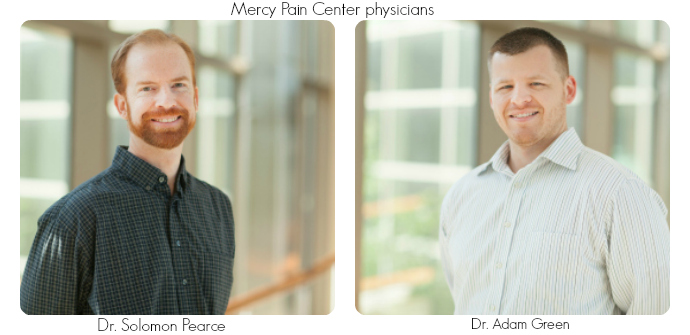Most of us know at least one person who deals with pain on a daily basis. You might even be that person. Pain management is such an important part of medicine, so we went to an expert at the Mercy Pain Centerto get more in-depth answers about this complex issue.
Dr. Solomon Pearce of the Mercy Pain Center gave us some thoughtful answers to our questions, so we’re featuring them in this two-part series of posts about managing pain. (Read the second installment next week.) If you or someone you know is dealing with chronic pain, we hope you’ll seek the advice of a qualified pain management specialist. (Pain management physicians receive specialized training in this area, so be sure to find the right doctor!)
What types of situations and/or conditions cause patients to seek the help of pain management physicians?
Patients who come to me are always seeking relief from some sort of suffering. This suffering comes in a variety of forms, sometimes very obvious (e.g. I have a herniated disc in my back), sometimes very complicated (e.g. I’ve had pain for years all over my body; I’m tired all the time, and I can’t sleep) and sometimes very dangerous (e.g. I’ve had pain for years, all that works is Dilaudid with oxycodone, and hydrocodone, and you HAVE to give me medication).
Does pain management mostly involve medication? Are there additional therapies that are effective at managing pain?
Real chronic pain management never involves just one treatment modality. Acute pain, sure… my son scrapes his elbow, I put a Band-aid on it and we’re done. My wife’s knee hurts after a run, so she uses some Ibuprofen — all better. However pain that has lasted more than three to six months, day in and day out, has become chronic; it has changed the person. It has affected their emotions, how they move in certain circumstances and what they do on a day to day basis. It truly changes how they live their life.
Thinking that all this damage can be repaired with one magic pill is silly. A good pain management physician should investigate all the areas that may have been effected and prescribe an individualized treatment program. This can include getting the person into physical therapy to work on body mechanics and strengthening exercises, occupational therapy to work on improving their function, cognitive behavioral therapy and biofeedback to help with coping and pain relieving strategies, acupuncture, prolotherapy, massage, aqua therapy, exercise programs, osteopathic manipulation etc.
Some patients need interventions with injections or radiofrequency ablation, spinal cord stimulators, or surgeries. Some need medications, and some need diet modifications. Each patient is different and I find a therapeutic approach which uses a combination addressing all their concerns in order to provide substantial improvement.
Addiction to pain medication has become a much bigger problem in our country in recent years. How do you counsel patients to help prevent these addiction issues?
I agree that our country has a significant problem with opioids. I think that the recent increase is a societal problem that can be partly attributed to physicians and to patients. Some physicians have forgotten how to say “no.” There are certain conditions and certain patient risk factors that make prescribing opioids the wrong choice of therapy.
Way too often I see patients being prescribed opioids for years that never should have been started on them in the first place. It’s hard to tell someone who is suffering “no,” but when addictive drugs may make their problem worse, it’s the right thing to do.
Some patients have becoming increasingly fixated on finding a magic pill that takes away all their pain. The media is constantly telling them there’s a quick fix around the corner and that they can just lay back and everything will be perfect. That’s not reality, but that doesn’t stop some people from seeking that end and getting themselves into trouble.
I avoid addiction problems for my patients in a number of ways. First I thoroughly evaluate each patient’s history, physical exam and diagnostic testing to find the appropriate treatment modalities for that specific patient. I screen all patients for signs of pre-existing tendencies which may indicate they could have addiction problems later on or reasons why opioid pain medication would be contraindicated for them prior to starting any treatment plan.
I strictly control access to prescription medication and monitor for compliance with my instructions through drug screening, prescription monitoring programs, and random pill counts. I always use the lowest possible dose to control their symptoms enough so patients can improve their function. This works very well to reduce the risks of addiction or drug diversion.
Are all pain medications habit forming? How would a patient know if he or she has developed an addiction?
No, not all substances that have pain relieving properties are habit-forming. I have a number of opportunities to interfere with pain signals during their transduction, transmission, modulation and perception. I use a variety of medication classes from topical agents, local anesthetics, anti-inflammatories, blood pressure medications, antidepressants and vitamin supplements which all have no habit-forming traits.
I also use some muscle relaxants, anxiolytics, anticonvulsants, and opioids that can be habit-forming (but not all of them are habit-forming.) If taken appropriately, these medications are very safe.
There’s a big misunderstanding in the general population about the difference between physical dependence and addiction.
Addiction is the inappropriate chronic use of a substance with impaired control of one’s ability to stop using it, feeling as though you have to use it, using that substance even though it causes you harm, and getting cravings for that substance. Medications can do this, alcohol can do this, gambling, sex and even food can become an addiction.
Physical dependence on the other hand simply means that your body comes to depend on a substance to function properly. Examples for this would be how some people are dependent on their coffee to wake up in the morning. A diabetic who uses insulin is dependent on their insulin to control their blood sugar. And some pain patients become dependent on a medication to be able to function throughout their day. This is normal. These people are not going from doctor’s office to doctor’s office seeking more meds or buying them on the street or smoking, snorting, or injecting medication. They are just patients living their normal lives, taking a medication every day, like people do for blood pressure or birth control.
Craving is usually one of the first signs a patient would notice if they were developing an addiction — that feeling that you just have to have something. It becomes all you think about. A person developing an addiction might start using more medication than directed, running out early, or trying to find other places to get medication from.
We’ll continue Dr. Solomon’s answers to our questions about pain management in an upcoming post next week.
Our thanks to Dr. Solomon Pearce at the Mercy Pain Center for taking the time to answer our questions. Dr. Pearce is Double Board Certified in Pain Medicine and Physical Medicine and Rehabilitation. Before coming to Arkansas, Dr. Pearce was a Naval Flight Surgeon who served in multiple overseas deployments. For more information or to schedule a consultation with Dr. Pearce or his colleague Dr. Green at the Mercy Pain Center, call (479) 986-6199 or click HERE for more clinic info.




